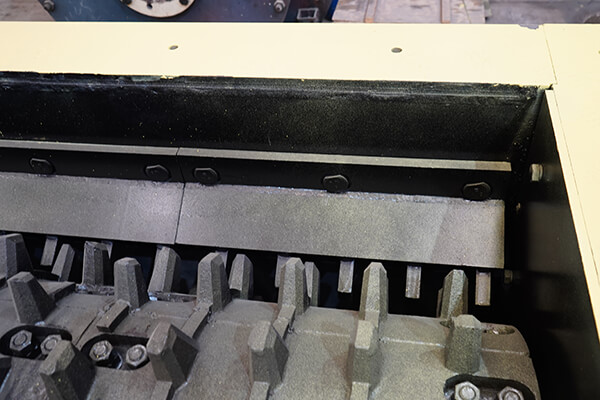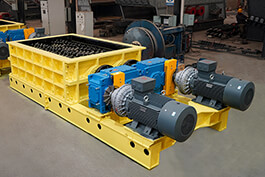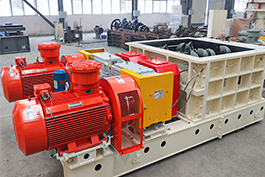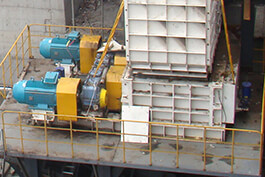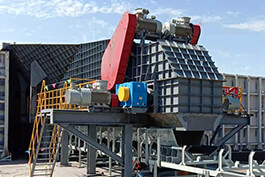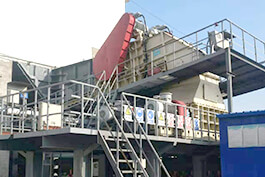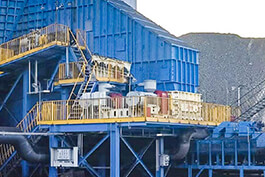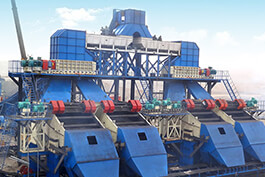Mineral sizer is a new type of crushing equipment that rotates in the opposite direction and crushes materials through forms such as stretching and shearing. Due to its unique advantages, it is widely used in fields such as coal and mining. It can crush hard materials as well as soft and sticky wet materials without material jamming or blockage. Then, in the process of crushing ores, wear resistance becomes extremely important. Therefore, we installed high manganese steel liners made of nm500 material on the part of the mineral sizer casing that comes into contact with the materials. However, when installing the liner, countersunk bolts must be used to prevent the material from damaging the bolts and causing the wear-resistant liner to fall off. The following are the main factors for using countersunk bolts when installing wear-resistant liners with mineral sizer.
Avoid direct wear of the bolt head
The working environment of wear-resistant liners: They are typically used as inner linings of equipment in mines, power plants, cement plants, etc. (such as hoppers, pipelines, crusher cavities, etc.), and need to withstand the high-speed scouring, impact and friction of materials.
Defects of common bolts: If common bolts (such as hexagonal head bolts) are used, the bolt head will protrude from the surface of the liner, directly exposed to the material flow, and will be quickly worn and flattened, causing the bolt to loosen or even fall off, resulting in the failure of the liner.
Advantages of countersunk bolts: The head of a countersunk bolt is conical. When installed, it is embedded in the pre-processed countersunk hole of the liner plate, making the bolt head flush with or slightly lower than the surface of the liner plate. In this way, the material flow directly contacts the wear-resistant surface of the liner rather than the head of the bolt, significantly reducing the risk of bolt wear and extending the service life of the fixing system.
2. Keep the surface smooth to reduce material retention and wear
The smooth surface of the
mineral sizer liner reduces resistance: After the countersunk bolts are installed, the surface of the liner is flat and continuous. When the material flows, the resistance is small and it is not easy to be retained or accumulated. If the head of the bolt protrudes, it may form a "Notch", causing the material to get stuck and vortex, and accelerating local wear (such as the liner around the bolt being washed out of the groove).
Avoid stress concentration: A flat surface enables the impact load of the material to be evenly distributed on the liner rather than concentrated around the bolt head, reducing the risk of the liner cracking due to excessive local stress.
3. Enhance the reliability of bolt connections
Shear and uplift resistance performance: The conical head of the countersunk bolt is closely attached to the countersunk hole. When the liner is subjected to lateral impact or vibration, the inclined surface of the bolt head can provide a certain shear resistance force to prevent the bolt from being cut or loosened laterally.
Anti-loosening design adaptation: When used in conjunction with anti-loosening washers (such as spring washers, lock nuts) or bonding processes, the countersunk structure can more stably fix the liner, preventing bolts from loosening due to vibration. It is particularly suitable for equipment with high-frequency vibration (such as vibrating screens, feeders).
4. Easy to install and maintain
Standardized installation process: The countersunk bolts need to fit precisely with the countersunk holes of the mineral sizer liner (the hole diameter and depth need to be processed in advance) to ensure a flat surface after installation. This process can be standardized through mechanical processing to improve the installation efficiency.
Convenience of replacement: When the liner is worn and needs to be replaced, the smooth surface makes it easy for tools (such as wrenches, screwdrivers) to operate directly without the need for additional space to avoid protruding bolt heads, thus shortening maintenance time. Meanwhile, after the old bolts are removed, the new liner can be directly attached and installed, avoiding positioning deviations caused by damage to the bolt holes.
5. Compatibility of materials with working conditions
High-strength material matching: Countersunk bolts typically use high-strength steel (such as stainless steel, alloy structural steel), and their mechanical properties match those of wear-resistant liners (such as high manganese steel, wear-resistant ceramics, chromium carbide composite plates), ensuring that the bolts themselves do not fail before the liners under high loads.
Corrosion-resistant scenarios: In corrosive environments (such as the chemical industry), countersunk bolts can be coated with anti-corrosion coatings (such as hot-dip galvanizing, dacromet) or made of stainless steel to prevent rusting and breakage of the bolts, while also ensuring a smooth surface to reduce the retention of corrosive media.
Summary: The core value of countersunk bolts
The countersunk bolts solve the "Weak point" Problem of wear-resistant liners in high-wear environments through concealed installation, balancing the fixing strength, surface flatness and anti-wear ability. It is a classic solution for the wear-resistant structure design of
mineral sizer. If there are extreme impacts in the working conditions (such as crushers), the connection reliability can be further strengthened by combining countersunk welding or anti-loosening nuts.


.jpg)
